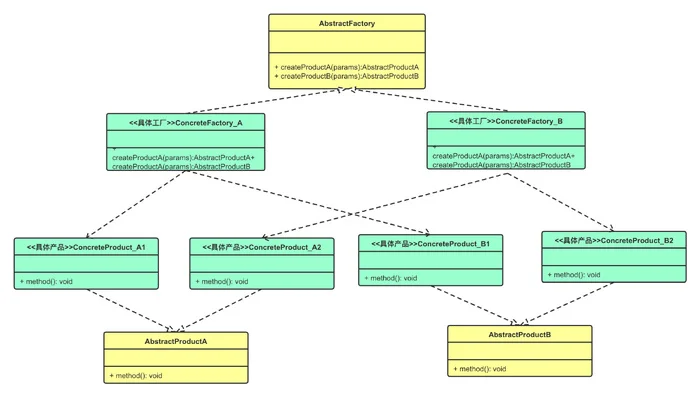之前我们介绍了工厂,现在我们再看一下抽象工厂设计模式。抽象工程模式顾名思义就是对工厂模式的一层抽象,也是创建型模式的一种,通常用来创建一组存在相关性的对象。
UML类图大致如下:

类图比较复杂,最好用个例子来说明。比方说,国内有两家生产运动服的工厂:nike和adidas 。现在我们想购买一套运动服,包含短裤(short)和运动鞋(shoe)。通常我们都会在同一家工厂购买整套的运动服。这时抽象工厂模式就可以发挥作用了。
现在我们需要的产品有两种:短裤(short)和运动鞋(shoe)。
生产这些产品的工厂有两家:nike和adidas。
iSportsFactory然后,我们还要为具体的产品定义两个接口:
iShortnikeShortadidasShortiShoenikeShoeadidasShoe看下具体的代码:
iSportsFactory.go
packagemainimport"fmt"typeiSportsFactory interface{ makeShoe() iShoe makeShort() iShort}funcgetSportsFactory(brand string) (iSportsFactory, error) { ifbrand == "adidas"{ return&adidas{}, nil } ifbrand == "nike"{ return&nike{}, nil } returnnil, fmt.Errorf("Wrong brand type passed")}iShort.go
packagemaintypeiShort interface{ setLogo(logo string) setSize(size int) getLogo() string getSize() int}typeshort struct{ logo string size int}func(s *short) setLogo(logo string) { s.logo = logo}func(s *short) getLogo() string { returns.logo}func(s *short) setSize(size int) { s.size = size}func(s *short) getSize() int { returns.size}iShoe.go
packagemaintypeiShoe interface{ setLogo(logo string) setSize(size int) getLogo() string getSize() int}typeshoe struct{ logo string size int}func(s *shoe) setLogo(logo string) { s.logo = logo}func(s *shoe) getLogo() string { returns.logo}func(s *shoe) setSize(size int) { s.size = size}func(s *shoe) getSize() int { returns.size}nike.go
packagemaintypenike struct{}typenikeShoe struct{ shoe}typenikeShort struct{ short}func(n *nike) makeShoe() iShoe { return&nikeShoe{ shoe: shoe{ logo: "nike", size: 14, }, }}func(n *nike) makeShort() iShort { return&nikeShort{ short: short{ logo: "nike", size: 14, }, }}adidas.go
packagemaintypeadidas struct{}typeadidasShoe struct{ shoe}typeadidasShort struct{ short}func(a *adidas) makeShoe() iShoe { return&adidasShoe{ shoe: shoe{ logo: "adidas", size: 14, }, }}func(a *adidas) makeShort() iShort { return&adidasShort{ short: short{ logo: "adidas", size: 14, }, }}main.go
packagemainimport"fmt"funcmain() { adidasFactory, _ := getSportsFactory("adidas") nikeFactory, _ := getSportsFactory("nike") nikeShoe := nikeFactory.makeShoe() nikeShort := nikeFactory.makeShort() adidasShoe := adidasFactory.makeShoe() adidasShort := adidasFactory.makeShort() printShoeDetails(nikeShoe) printShortDetails(nikeShort) printShoeDetails(adidasShoe) printShortDetails(adidasShort)}funcprintShoeDetails(s iShoe) { fmt.Printf("Logo: %s", s.getLogo()) fmt.Println() fmt.Printf("Size: %d", s.getSize()) fmt.Println()}funcprintShortDetails(s iShort) { fmt.Printf("Logo: %s", s.getLogo()) fmt.Println() fmt.Printf("Size: %d", s.getSize()) fmt.Println()}End!
